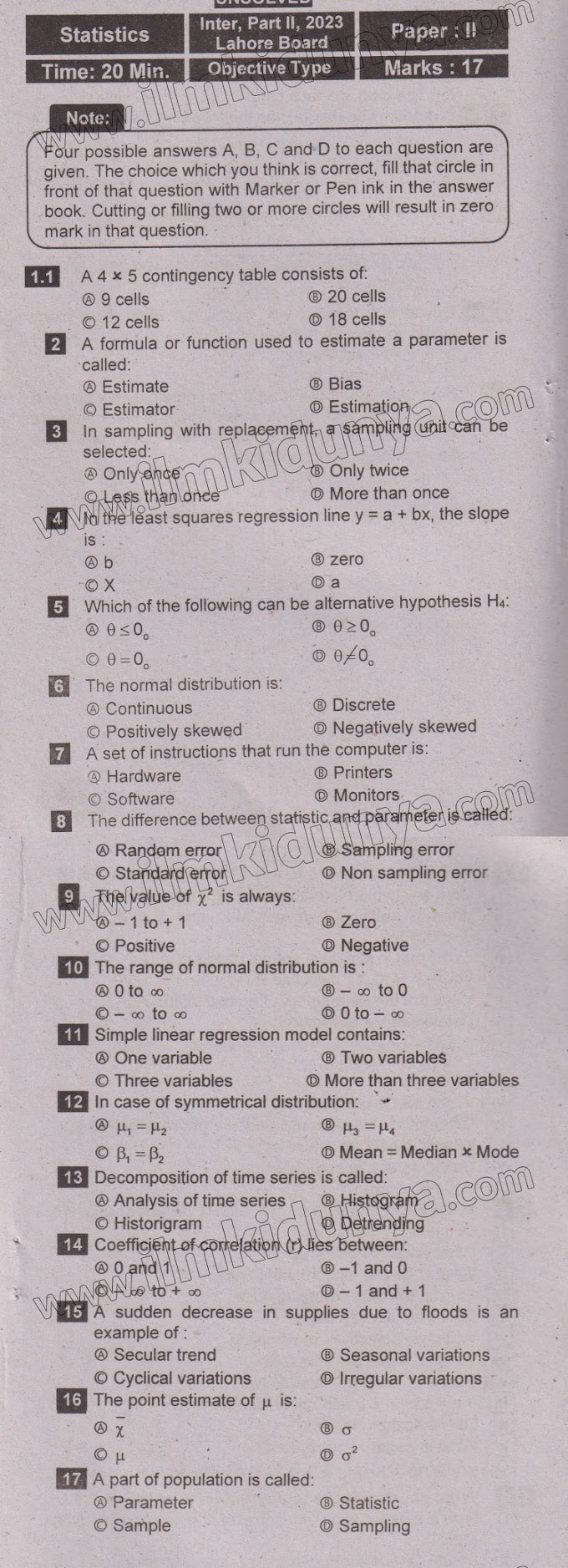Here you will see important short questions and important definitions of chapter 13 Hypothesis Testing.
Only request is to subscribe to this channel on youtube Welcome Academy for more videos about your paper.
12th class statistics chapter 13,Hypothesis Testing,important definitions and short questions,2nd year class statistics
If you have any questions please leave a comment here,I will be very thankful to see your question.
#12thcalssstatistics #chapter13 #hypothesistesting #shortquestions #definitionitons @12thcalssstatistics @chapter13 @hypothesistesting @shortquestions @definitionitons
#welcomeacademy
Chapter 13: Hypothesis Testing
These are very important question according to paper pattern.
Q.1 What is test statistic?
ANS: The test statistic is a sample statistic which provided a basis for
deciding whether or not the null hypothesis should be rejected. The
most commonly used test statistic are Z, t, χ2. etc.
Q.2 Does α + β =1? Why or why not?
ANS: No, α + β ≠1, because α is the probability of type – I error and β is theprobability of type – II error.
Q.3 Define simple hypothesis and composite hypothesis.
ANS: A statistical hypothesis is said to be a simple hypothesis if it
completely specifies.
A statistical hypothesis is said to be a composite hypothesis if it does
not completely specifies.
Q.4 What is null hypothesis?
ANS: It is defined as the hypothesis which is tested for its possible rejection
under the assumption that it is true. It is denoted by Ho.
Q.5 Define type – I error with example.
ANS: Reject Ho when Ho is true is called type – I error. For example: A judge rejecting a candidate who is fit for job.
Q.6 Define type – II error with example.
ANS: Accept Ho when Ho is false is called type – II error. For example: A teacher passing a week student.
Q.7 Distinguish between one sided and two sided test.
ANS: A test for which the critical region lies on one side of the sampling distribution of a test statistic is called one – tailed test.
A test for which the critical region lies on both sides of the sampling
distribution of a test statistic is called two – tailed test.
Q.8 Define statistical hypothesis.
ANS: An assumption about the unknown value of population parameter from which the sample is drawn and it may be true or false is called statistical hypothesis.
Q.9 Define α and β.
ANS: Alpha (α) indicate the probability of committing type – I error.
Beta (β) indicates the probability of committing type – II error.
Q.10 What do you understand by level of significance?
ANS: The probability of rejecting true Ho is called level of significance. It is denoted by α.
Q.11 Under which circumstances we may use (a) Z – test (b) t – test.
ANS: Z Test: The test statistic Z is used when the population is normal and variance is known, or the sample size is small and large and population variance is unknown sample size is large.
t Test: The test statistic t is used when the population is normal and
variance is unknown and the sample size is small n ≤ 30.
Q.12 Discuss acceptance and rejection region.
ANS: Acceptance region specifies a set of values of the test statistic for which the null hypothesis is not rejected. It is also called non criticalregion.
A rejection region specifies a set of the values of the test statistic for which the null hypothesis is rejected. It is also called critical region.
Q.13What are critical values? Where do they come from?
ANS: The values of the test statistic which separate the rejection and non-rejection regions for the test called critical values. Critical value comes from test statistic.
Q.14Express alternative hypothesis.
ANS: An alternative hypothesis is that hypothesis which we are willing to accept when the null hypothesis is rejected.
(OR A hypothesis which is different from null hypothesis and accepted when null hypothesis is rejected is called alternative hypothesis.) It is denoted by H1.
Q.15What is meant by degree of freedom?
ANS:The number of independent or freely selected observations is called degrees of freedom.
Q.16 What is power of test?
ANS:The probability of rejecting the false Ho is called power of test.
Power test = 1 - β











0 Comments
Thanks for message us We shall approve it if you have oxygen like words for us